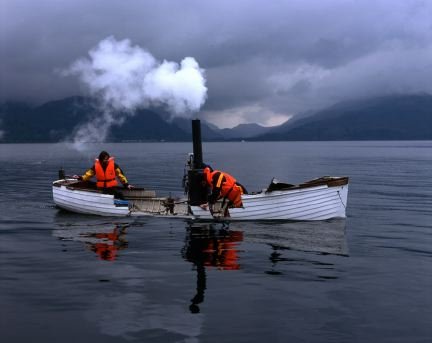Simon Starling
dal 15/2/2007 al 23/3/2007
Segnalato da
15/2/2007
Simon Starling
Casey Kaplan Gallery, New York
The exhibited projects all resurrect outmoded or obsolete forms of technology and link the micro world of the electron microscope, of chemistry and physics, to the wider world of objects and images, a world in which processes of creation and destruction appear inevitably linked. This constellation of works is typical of recent developments in Starling's practice as they shift between process, performance, sculpture and photography.

Solo photography exhibition
For his third solo exhibition at Casey Kaplan, Simon Starling continues to
develop an interest in the fundamental building blocks of art practice, the
stuff of making, and attempts to link particular materials to their
geographical, political and cultural roots. Selected for their connections
and contradictions, the exhibited projects all resurrect outmoded or
obsolete forms of technology and link the micro world of the electron
microscope, of chemistry and physics, to the wider world of objects and
images, a world in which processes of creation and destruction, and energy
and entropy appear inevitably linked. This constellation of works is typical
of recent developments in Starling¹s practice as they shift between process,
performance, sculpture and photography.
Commissioned by Cove Park, Scotland, Autoxylopyrocycloboros has its roots
both in the pioneering development of steamboat technology in the Clyde
Estuary and in the brooding presence of the Trident nuclear submarines based
at neighboring Coulport and Faslane. Realized in October 2006,
Autoxylopyrocycloboros began with a circular, entropic voyage on the waters
of Loch Long. The boat that made the voyage, a 20ft long, clinker-built
wooden craft named Dignity, built around 1900 as a steam launch on Lake
Windemere, was salvaged from the bottom of Loch Lomond by its previous owner
and restored to working order. Newly fitted with a single cylinder, marine
steam engine, Dignity served as both vessel and fuel for
Autoxylopyrocycloboros as, piece-by-piece and plank-by-plank, the boat was
fed to its own boiler. Like the age-old alchemical symbol for eternal
renewal, the Ouroboros (the tail devouring snake), the boat, in an attempt
to keep moving, consumed itself and ultimately returned to the deep,
submarine infested waters of the Loch Long. The resulting work documents
this event in 38 medium format transparencies exhibited on a resolutely
mechanical projector.
In Gold Toned Okapi, Starling utilizes existing source material to create a
new series of photographic prints. Starling looked to Herbert Lang, a
scientist and an accomplished field photographer who¹s perhaps best known
for producing the first photographic images of the Okapi, an ancient
relative of the Giraffe, while on a biological survey of North Eastern Congo
for the American Museum of Natural History. The images of the creature were
made in the Ituri region of the Congo, which is now infamous for its
conflict over the regions¹ gold deposits, which are mined in unregulated
artesian mines, and illegally traded to American and European gold refiners.
Lang¹s photographs of the Okapi were produced using glass-plate negatives
and printed using the then standard technique of POP (print out paper)
printing. This method of printing requires a gold toning process to fix the
image. In Gold Toned Okapi, Starling worked with a single image originally
produced by Lang in 1913. The gold toner used to fix Starling¹s images was
produced using part of a 1oz bar of gold manufactured by the Swiss gold
refiner, Metalor, who was recently found to be exporting large quantities of
gold from Uganda - gold that has subsequently been traced back to traders in
the Democratic Republic of Congo. Starling¹s gold tainted photographs
conflate different geographical points and moments in history, offering a
subtle comment on recent international trade.
Paralleling Gold Toned Okapi, Starling has transformed a traditional strip
canoe (akin to those built in North America since the 1880¹s that were in
turn derived from the Native American birch bark canoe) by using African
hardwoods in its construction. The resulting stripped markings on its
exterior allude to the camouflaged skin of the Okapi. In this way, the work
becomes a hybrid object: part African, part American, part working-canoe,
part sculpture, part pantomime costume. While clearly referencing Lang¹s
Congo expedition, the canoe proposes a modern day journey out of New York,
back up the Hudson River and beyond.
Simon Starling was the recipient of the 2005 Turner Prize by Tate Britain,
London, and was short-listed for the 2004 Hugo Boss Prize by the Solomon R.
Guggenheim Museum, NY. A solo show at Städtischen Kunstmuseum zum Museum
Folkwang in Essen, Germany opens in April 2007. His 2005 solo exhibition
³Cuttings² which was on view at the Kunstmuseum Basel, Museum für
Gegenwartskunst will travel to The Power Plant in Toronto in 2007. A solo
show is also planned with M.I.T. & Mass MOCA, North Adams, MA in 2008. Other
solo exhibitions include: Villa Arson Nice, France; MACRO, Rome, Italy;
Dundee Contemporary Arts, Dundee, Scotland, and Museum of Modern Art,
Sydney, Australia. The artist represented Scotland in the 50th International
Exhibition of Art, Venice Biennale, Italy, 2003.
Image details: Simon Starling 'Autoxylopyrocycloboros,' 2006 38, 6x7cm (2.36 x 2.75²) color transparencies,1 goetschmann slide projector Dimensions variable Detail Edition of 5
Opening reception: feb 16th, 6-8pm
Casey Kaplan
525 West 21st Street - New York
Opening time: tue - sat 10 - 6pm
Admission free



